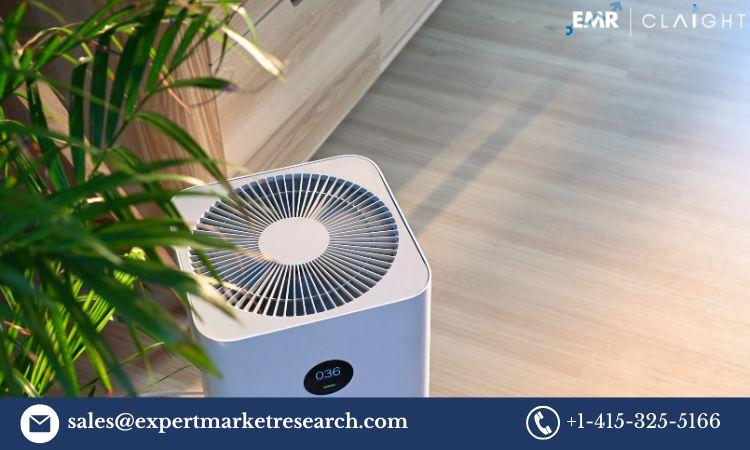Air Purifier Market Outlook (2025-2033): Drivers, Trends, and Growth Opportunities

The global air purifier market size has witnessed impressive growth, reaching a value of approximately USD 14.91 billion in 2024. With an increasing focus on air quality and its impact on health, the demand for air purifiers is expected to rise sharply in the coming years. The market is projected to grow at a compound annual growth rate (CAGR) of 10.00% from 2025 to 2033, reaching a value of around USD 35.16 billion by 2033. This growth is driven by a combination of factors such as rising pollution levels, growing awareness about the importance of indoor air quality, and advancements in air purification technology. In this blog post, we will explore the market dynamics, key drivers, trends, challenges, and future opportunities for the global air purifier market.
Key Drivers of Market Growth
-
Rising Air Pollution Levels
One of the primary drivers of the air purifier market is the increasing levels of air pollution, particularly in urban areas. Industrialisation, vehicular emissions, and other environmental factors have led to a significant deterioration in air quality, both outdoors and indoors. According to the World Health Organization (WHO), more than 90% of the world’s population breathes polluted air, which is linked to various health problems such as respiratory diseases, heart conditions, and even cancer. As people become more concerned about the health implications of poor air quality, the demand for air purifiers has surged.
-
Growing Health Awareness
As awareness about the health risks associated with poor air quality grows, consumers are increasingly prioritising clean air in their homes and workplaces. Studies have shown that indoor air can be up to five times more polluted than outdoor air, due to factors such as household chemicals, dust, pet dander, and mould. Air purifiers are being recognised as an essential appliance in improving indoor air quality, particularly for individuals with respiratory issues such as asthma and allergies. This growing health consciousness is expected to drive the demand for air purifiers in residential, commercial, and industrial spaces.
-
Technological Advancements in Air Purification
Technological innovations in air purification are another major factor driving market growth. Modern air purifiers are equipped with advanced filtration technologies such as HEPA (High-Efficiency Particulate Air), activated carbon, and UV-C light to effectively remove a wide range of airborne pollutants, including fine particulate matter (PM2.5), volatile organic compounds (VOCs), bacteria, viruses, and allergens. Some air purifiers are also integrated with smart features, allowing users to control the device remotely via mobile apps or voice commands. These innovations have made air purifiers more efficient, user-friendly, and accessible, which is expected to further boost their adoption.
-
Increased Urbanisation
The rapid pace of urbanisation, particularly in emerging economies, has led to an increase in pollution levels, which further drives the demand for air purifiers. As more people migrate to cities and urban areas, the air quality continues to worsen due to increased vehicular traffic, industrial activity, and construction. As a result, both residential and commercial consumers in urban areas are more likely to invest in air purifiers to ensure a healthier indoor environment. This trend is expected to remain a key driver of the air purifier market’s growth.
Challenges Facing the Market
-
High Initial Investment and Operating Costs
One of the primary challenges in the global air purifier market is the high initial cost of these devices, especially for advanced models with smart features. While air purifiers have become more affordable in recent years, premium models equipped with advanced filtration technologies can still be relatively expensive. Additionally, the cost of replacing filters and maintaining the devices can add to the overall expenditure. This can be a barrier to adoption for some price-sensitive consumers, particularly in developing countries where disposable income is lower.
-
Limited Consumer Awareness in Developing Markets
While air purifiers are well established in developed markets, there is still limited awareness of these devices in many developing economies. In countries where air pollution is not seen as a major concern or where people are unaware of the health risks associated with poor air quality, the adoption of air purifiers remains low. Overcoming this lack of awareness and educating consumers about the benefits of air purifiers will be essential for expanding the market in these regions.
-
Competition from DIY and Inexpensive Solutions
The air purifier market also faces competition from DIY air-cleaning methods and low-cost, less effective solutions. Many consumers opt for home remedies such as houseplants, air sprays, or inexpensive filters that may not be as effective as professional air purifiers. Although these alternatives do not offer the same level of efficiency as advanced air purifiers, they may still appeal to budget-conscious consumers. The market will need to differentiate high-quality air purifiers from these cheaper alternatives to maintain growth.
Key Trends Shaping the Future of the Air Purifier Market
-
Integration of Smart Technologies
The integration of smart technologies is one of the key trends shaping the future of the air purifier market. Modern air purifiers are increasingly incorporating Wi-Fi connectivity, allowing users to monitor and control the device remotely using smartphone apps. Voice-controlled air purifiers, powered by virtual assistants like Alexa and Google Assistant, are also gaining popularity. These smart air purifiers offer convenience and real-time data on air quality, filter replacement, and energy usage, making them an attractive option for tech-savvy consumers.
-
Increased Focus on Energy Efficiency
As environmental concerns grow, consumers are becoming more conscious of the energy consumption of household appliances, including air purifiers. Manufacturers are focusing on improving the energy efficiency of their devices to meet consumer demand for eco-friendly solutions. Energy-efficient models not only reduce electricity bills but also contribute to sustainability by lowering the carbon footprint. The development of energy-efficient air purifiers is expected to be a key trend in the market in the coming years.
-
Rise in Commercial and Industrial Applications
While the residential sector currently dominates the air purifier market, there is a growing demand for air purifiers in commercial and industrial applications. Offices, hospitals, schools, and public buildings are increasingly adopting air purifiers to improve indoor air quality and protect the health of employees, patients, and visitors. In particular, the healthcare sector is a major end-user, as clean air is essential for preventing the spread of infectious diseases. The demand for air purifiers in these sectors is expected to increase significantly during the forecast period.
Market Segmentation
The global air purifier market can be segmented by technology, application, and region:
-
By Technology: The key technologies used in air purifiers include HEPA, activated carbon, ionizer, and UV-C light. HEPA filters hold the largest market share due to their efficiency in capturing fine particles and allergens.
-
By Application: The residential segment accounts for the largest share, followed by the commercial and industrial sectors. The demand for air purifiers in commercial spaces is expected to rise significantly, driven by increasing awareness of indoor air quality.
-
By Region: North America, Europe, and Asia-Pacific are the key markets for air purifiers. The Asia-Pacific region is expected to see the fastest growth, particularly in countries like China and India, due to increasing urbanisation and pollution levels.
- Art
- Causes
- Artisanat
- Danse
- Boissons
- Cinéma
- Fitness
- Cuisine
- Jeux
- Jardinage
- Santé
- Maison
- Littérature
- Musique
- Réseautage
- Autre
- Fête
- Religion
- Shopping
- Sports
- Théâtre
- Bien-être


